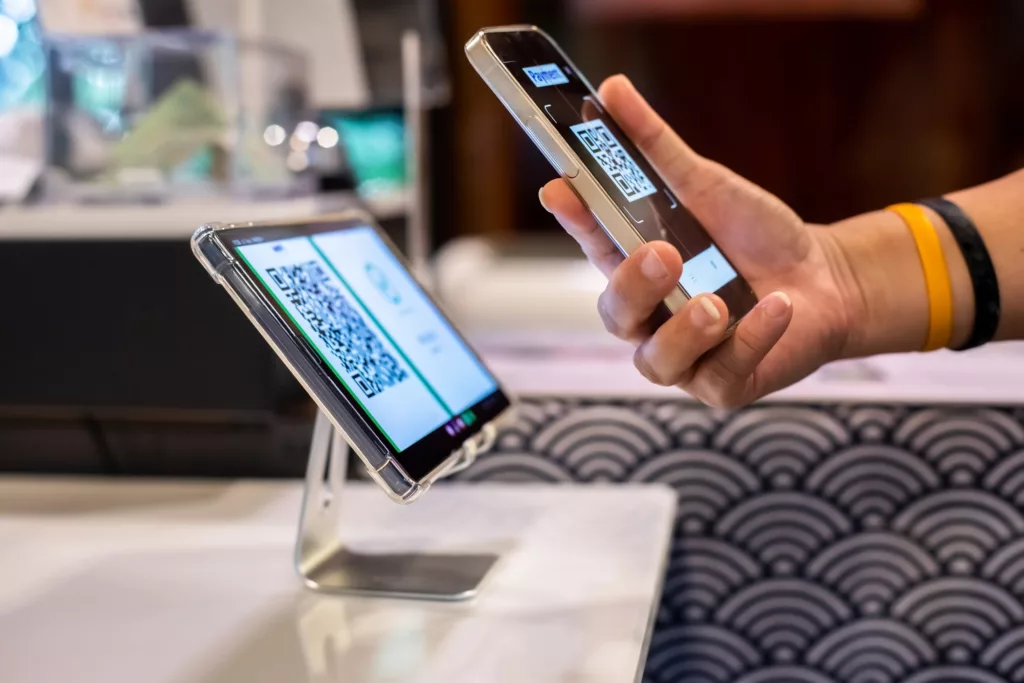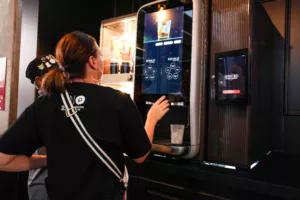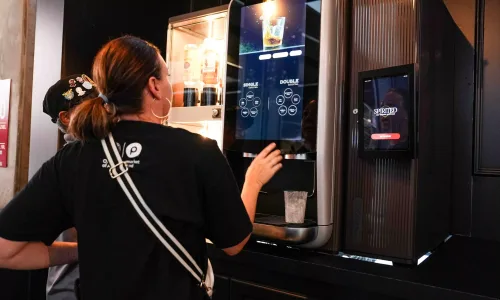KEY TAKEAWAYS
- QR codes have several prime uses in the hospital industry, like accessing menus, services, and facilities.
- Deploying QR codes effectively means understanding where and when this technology is—and isn’t—appropriate.
- Facial authentication will likely take over these use cases in the future, thanks to better-suited tech.
We’ve all experienced it. That moment at the restaurant when you’re wondering where the menu is. The server finally directs your attention to the collection of black and white squares taped to the table. They warmly tell you to scan the QR code, where you can order, and even how to pay.
QR codes became popular as the hospitality industry made an effort to keep pace with technological advancements. These versatile, scannable codes have been widely used in hotels, restaurants, and other businesses. Their ease of use makes it easy to see why.
However, QR codes have some significant limitations, and in certain scenarios, better options do exist. Here, we’ll take a comprehensive look at QR codes, including why they resonate, how and when they’re used, and what technology might (partially) replace them.
Why Did QR Codes Catch On?
QR codes stuck because they cater to a greater trend across hospitality and entertainment: self-service. The fact is, people like being empowered to accomplish something without having to wait for it. Why? Because however luxurious it is to be waited on by a third party, it’s you who spends time waiting. For that reason, the meaning of “premium” is evolving before our very eyes. It doesn’t mean waiting around anymore. It means helping people access, explore, and experience for themselves the moment they want to.
There’s also an appeal for businesses. Empowering self-service means less time and resources spent on physically serving the customer. Replacing printed items with digital or QR-code-gated assets also costs less than traditional printing, and it avoids the annoyance of having to update outdated print items. So as “premium” becomes synonymous with “self-service,” we see better outcomes for both user and staff, which makes their appeal perfectly logical.
How and When to Use QR Codes
There are a staggering number of use cases for QR codes today, from accessing digital assets faster than you can type a URL to paying for your meal. Below, we’ve compiled a few of the most common uses of QR codes within the hospitality industry, some of which are perfectly suited, and others that actually have a better alternative we’ll expand on later.
Digital Menus and Ordering
- How: QR codes that link to digital menus for restaurants, room service, or in-room dining.
- Where: Place these codes on table tents, in-room information booklets, or lobby displays.
Contactless Check-In and Check-Out
- How: QR codes for guests to scan upon arrival, linking to a digital check-in process.
- Where: Include in booking confirmation emails or display prominently at the reception desk.
Access to Wi-Fi
- How: QR codes that automatically connect guests to the wifi network.
- Where: Display in rooms, common areas, and include in welcome packets.
Feedback and Reviews
- How: QR codes that direct guests to feedback forms or review platforms.
- Where: Include on receipts, in-room materials, or at check-out points.
Loyalty Programs
- How: QR codes for easy sign-up or access to loyalty program accounts.
- Where: Display at check-in/check-out areas, in marketing emails, or on room key cards.
Event Information and Scheduling
- How: QR codes linking to event calendars, conference schedules, or activity bookings.
- Where: Include in event promotional materials, display near conference rooms, or in common areas.
Contactless Payments
- How: QR codes linking to payment portals for products, meals, etc.
- Where: Include on receipts, at point-of-sale terminals, or in-room for express check-out.
Limitations of QR Codes and the Promise of Facial Authentication
QR codes have undoubtedly improved aspects of the hospitality industry. And in certain cases, like accessing menus or other assets, they’re genuinely useful and will likely stick around. But when QR codes are used as “unique identifiers” for guests (for things like ticketing, guest check-in, or payment), they have clear shortcomings.
With this in mind, new solutions are emerging that could potentially replace or complement QR codes. Facial authentication is one such technology. Below, we’ll explore the disadvantages of QR codes and how FA could address them.
1. User Inconvenience
QR Codes are best suited to low-pressure situations, where you’re the sole customer and have no line waiting behind you. Otherwise, the introduction of a QR code can be genuinely annoying or even stressful. It means guests have to fumble around to retrieve their phones (and hope for some battery life), open their cameras, and scan the code with their device.
If they have to present a QR code themselves (as their ticket or confirmation code, for example), it gets even worse, forcing them to store and retrieve the QR code from their phone, all while in a rush.
Facial authentication eliminates this pain point entirely. When switched with QR codes in the context of tickets or payments, it provides a far more seamless, hands-free experience with no action required from the guest. Their face is their ticket or payment method. The line keeps moving. No stress, no inconvenience.
2. Device Dependency
Perhaps one of the biggest arguments against QR codes is that they nurture user dependence on devices with finite battery lives. Because QR codes require a smartphone or tablet with a camera, if their device is dead, the customer is simply out of luck. In the ticketing scenario, they could print it to avoid this—but that means they could also lose it.
You know what you can never lose and never needs to be charged (except perhaps with beauty sleep)? Your face. Facial authentication can work with existing security cameras or dedicated scanners, eliminating the dependence on end-user devices.
3. Environmental Interference
Low light situations can make it difficult for smartphone cameras to accurately capture the code’s pattern, potentially leading to failed scans or errors. Similarly, corrupt or partially obscured QR codes may not function properly, limiting their effectiveness in some settings. These limitations can be frustrating for users and may reduce the overall reliability of QR codes in variable environments.
By contrast, the top facial authentication systems perform well in various lighting and weather conditions and can easily navigate hats, scarves, and glasses. This ensures consistent usability, allowing users to access services without worrying that lighting or water damage could prevent their access to an event or make them unable to pay.
Of course, not every facial authentication platform is equipped to handle sub-optimal environments, so you’ll need to consider your needs carefully and do a little research to find the best option available.
4. Security Concerns
While QR codes offer convenience, they come with significant security risks. They can be easily copied or manipulated, exposing users to potential fraud scenarios. The inability to visually distinguish between legitimate and fraudulent QR codes heightens this vulnerability.
Facial authentication provides a higher level of security, using unique biometric data that is difficult to replicate. Advanced systems can differentiate between a live person and a static image, ensuring that only authorized individuals gain access to events and sensitive information, thereby enhancing overall security.
How Facial Authentication Could Transform Hospitality
Instead of scanning a QR code, facial authentication solutions mean guests can simply approach a kiosk equipped with the right software, smile for the camera, and get fast and secure access to their room or specific areas of a property. These systems can also help staff to greet guests by name and access their preferences instantly, further personalizing the service experience.
Rather than scanning a QR code for payment, guests could authorize charges by linking a credit card to their biometric facial token as they might with a digital wallet, streamlining the process and getting them faster access to the things they’re excited to experience. FA could also apply loyalty benefits and record points automatically, eliminating the need for guests to present cards or scan QR codes. Plus, in a post-pandemic world, facial authentication offers a completely touchless solution for various interactions, from elevator controls to amenity access.
While QR codes will continue to play a role in the near future, forward-thinking hospitality businesses should start exploring and preparing for the next wave of technological advancements, including facial authentication. By staying ahead of these trends, they can offer cutting-edge experiences that delight guests, streamline operations, and set their properties apart.







